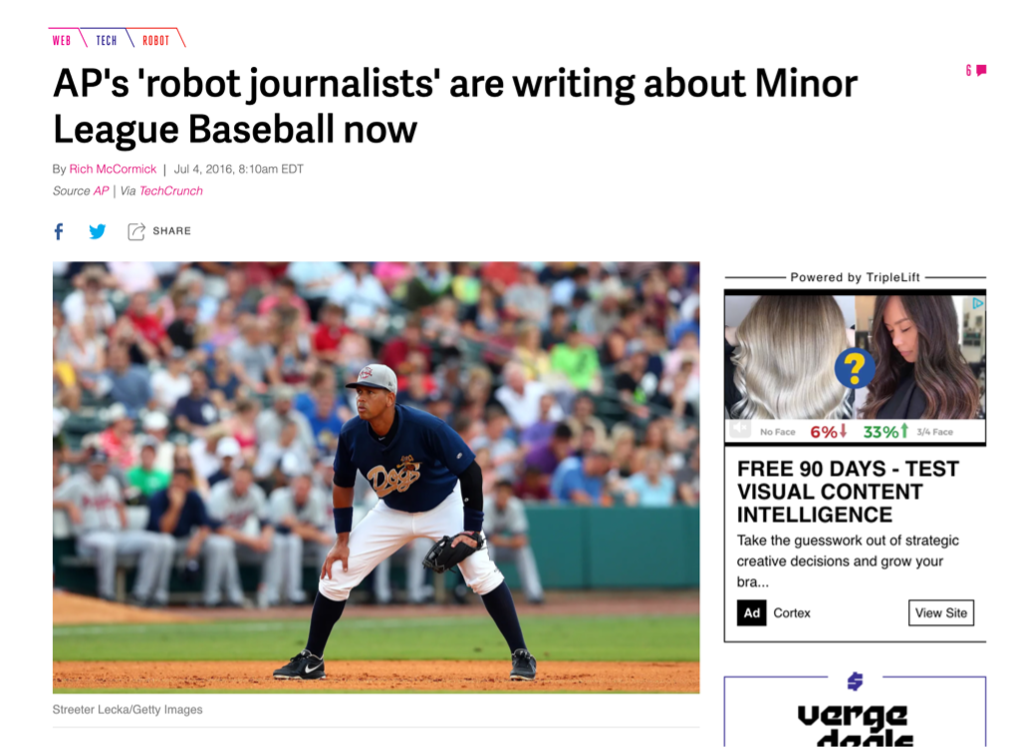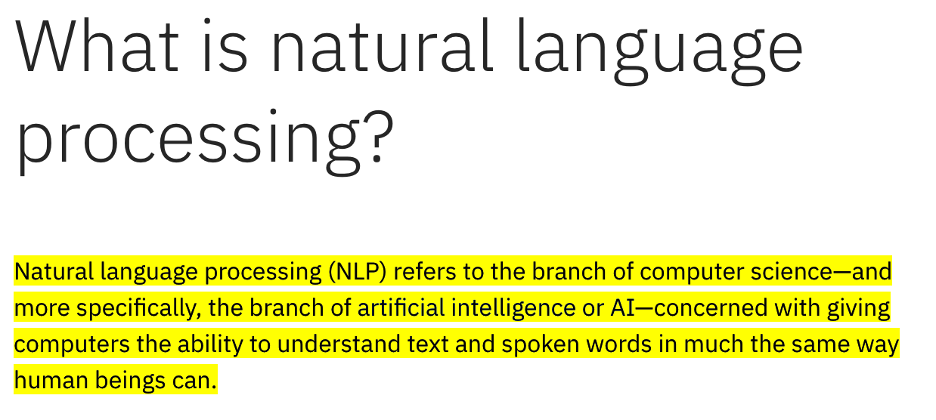How to (and not to) use AI for your product copywriting

Brian Hennessy
Talkoot CEO and Co-Founder
What is AI copywriting great for? What is it not so great for? How to use it to streamline your product copywriting?
I first read about AI copywriting tools in 2016 when I came across an article about how ‘robot journalists’ were already writing AP news articles.

Back then, I owned a writing studio that produces tens of thousands of product descriptions for many world-class brands. I was naturally concerned it might deal my writing studio a death blow.
Instead of sticking my head in the sand, though, I decided to lean in. My thinking: I’d rather figure out how I can use AI and bring it to my clients as a solution than have them bring it to me as an alternative to my writing services.
Those early apps were terrible, template-based solutions that were far less efficient than hiring a human to write the copy from scratch. Today’s Natural Language Processing (NLP) AI solutions, like OpenAI’s GPT-3, are a huge advance.

No doubt AI will replace some writers. But it will be rocket fuel for others. If you’re a talented copywriter able to create conceptual campaigns and connect emotionally with readers, you’ll find AI Copywriting tools an invaluable crutch for your more mundane writing tasks.
For writers who stick to more informational and/or direct response writing, there will be less and less work as marketing teams get more comfortable using AI.
Writer + Robot > Writer or Robot alone
The truth is, human writers are better at some things. AI writers are better at other things. But combined, they’re unstoppable. That is, once you learn how to use AI and which AI to use.
This article delves into the different types of AI-powered copywriting tools and the benefits and pitfalls of each. It also talks about how we’ve built Talkoot’s AI copywriting features so human writers and AI writers can work seamlessly together in a tool built for both.
Statistical and template-based AI models
The leap from these old-school AI models to NLP models was so transformative, they’re barely worth mentioning, so I’ll keep it brief. These AI models are designed for very data-driven reporting where the data changes, but the format of the report rarely does. Think of real estate reports, the outcome of baseball games, financial reporting, etc.
They work in a fill-in-the-blank fashion, where most of the sentence remains static, but the details change daily, weekly, or monthly. When it comes to product description writing, they’re all but useless.
OpenAI and GPT-3
We’d been looking for, and testing, AI solutions for a few years before the GPT-3 language model opened their API to commercial use in 2020.
When I first experienced tools built using GPT-3, I realized NLP AI had finally become valuable to copywriters. Not only that, GPT-3 is the most robust AI model in the world. I was very optimistic.
There are several different AI copywriting solutions based on GPT-3 out there now and more coming on the market all the time.
When I’m generating ideas for a landing page or blog post or looking for a new spin on a subject line, I use copysmith.ai. But there are others that are very similar. They have a slightly different UX, but they all use the same underlying language model so the results will be roughly the same, whichever you choose.
What they’re great for
If you’re a generalist who wears a lot of marketing hats and deals with lots of time, budget and writing skill constraints, these tools are built for you. You can write in a week what might have taken you all month to do on your own.
This is especially true if you’re doing a lot of “lower funnel” writing like direct response, benefit & feature copy, Facebook captions, email subject lines, etc. You’ll still need to do a fair bit of editing, but these tools are good at turning out lots of different ideas for you to begin with. Hit refresh enough and you’ll find some copy you can work with.
In short, the GPT-3 apps are solid general purpose writing tools, but they’re not designed to be great at any one thing.
How about product copy?
If you’re selling commodity-like products on marketplaces like Amazon, GPT-3 might work for you, with a bit of help from a human editor. The caption below is the kind of product descriptions you can expect with GPT-3. It reads a shade or two off-human—not something most would allow on their product page. But you can also see how, with a quick edit, this could be a serviceable description for a generic pair of yoga tights.

Generic product descriptions tell shoppers you sell generic products. via: Amazon
Retailers selling a very limited catalog of undifferentiated products via marketplaces or big box retailers might find these tools can take care of their product copy needs. But if any of the below sound like your situation, these tools likely won’t be a good fit for you:
- You have a large catalog/product line full of differentiated products
- You’re selling technical products that require detailed, accurate product descriptions
- You sell products targeted at a particular community or subculture (i.e., runners, organic gardeners, snowboarders)
- You have—or are trying to establish—a valuable brand that can support premium price points
Here are the 6 biggest reasons why generalized GPT-3 apps won’t work for these types of businesses (and why we built Talkoot for you).
1. Open AI can be too “open”
The biggest selling point of the GPT-3 model is that it pulls in data from the entire Internet. GPT-3 was trained on around 200 billion words. But its biggest selling point can also be its biggest problem.
When a language model is trained on the whole of the internet, it is—by definition—being trained on the best and worst of the internet. It can generate a product description, but it can’t distinguish between good and bad product descriptions.
It also can’t distinguish between your brand voice and your competitor’s. Which leads me to a few other problems with using general-use AI tools for product copywriting and how Talkoot solves them.
2. It will never learn your brand language or voice
When you hire a human writer, it might take them a few months before they’re confidently channeling your brand voice without heavy guidance or editing. Sadly, GPT-3 will never learn your brand voice. The mistakes it makes on day one will be the same mistakes it makes on day 2,346.
Talkoot’s language model can be trained on just your branded content alone—which means it will begin, day –one, with a good handle on how you like to speak about your products. And, just like a human writer, the more you use Talkoot, the better it will get at matching your brand voice.
3. Your content could show up in competitors’ copy and theirs can show up in yours
Since these models are trained with information from the whole internet and you and your competitors have similar products, it’s very likely you’ll see bits and pieces of your competitor’s language showing up in your product copy. In our tests, the AI would often talk explicitly about a competitor’s benefits, features and technologies, calling them out by name.
Because Talkoot is trained using your product copy only, your verbal identity is yours alone. Your competitors’ keywords and unique brand language will never show up in your copy.
4. It can’t write different copy for different consumers/collections/channels, etc.
As most online retailers grow, they need to fuel that growth by adding new collections, channels, and consumer segments. Often these different consumer segments buy for very different reasons. They also want to be talked to in a different way.
For instance, it takes a very different product description to sell a running shoe to a runner than it does a sneaker to a collector. With GPT-3 there’s no way, outside lots of heavy editing, to make sure you’re speaking in the right tone and communicating the right information to the right target consumer.
With Talkoot, instead of relying on a single language model for your entire store, you can spin up as many writers as you need. You can have one AI writer that specializes in your volume drivers and another that specializes in your halo products. You can have one that writes all your Star Wars licensed products and another for your Mickey Mouse merchandise.
For those editing your AI copywriting, Talkoot also offers a feature called BrandCenter. BrandCenter is basically an automated creative director built into Talkoot. It continually monitors your product copy for incorrect terminology, banned phrases and clichéd marketing speak, then offers up legally approved, on-brand alternatives.
5. You need to provide a specific type of input for each product
Each type of copy produced with these general-purpose tools requires a specific, predefined set of input as prompts to the AI writer. This makes sense when you need copy for just a handful of products. But when you’re dealing with hundreds or thousands of products on an ongoing basis, providing additional input for each product can add up to a lot of additional labor.
Talkoot can be trained to work with the product data you already have. Once we’ve mapped our language models to your data, you only need to upload your data in the same format every time to get results.
Better yet, Talkoot integrates with many of the most popular ecommerce platforms, PLMs and PIMs, so those dataflows can be fully automated.
6. General-purpose AI tools are jack of all trades, master of none
Beyond the drawbacks of using GPT-3 for your product copy, the very way these tools are designed makes them ok at lots of things, but not great at any one thing. Personally, all the tools that I love most in my work life are optimized to the specific task I need them to do. Which is exactly why we built Talkoot.
Before Talkoot there was no tool built specifically for high-speed, high-volume, high-quality product content production. Talkoot is built so you can get the best out of your entire team. AI writers and human writers, editors and approvers have everything they need to work effortlessly together.
Hot take?@copy_ai raises the floor, but not the ceiling.
— 🔥 FireTeam: An agency on fire... (@HireFireTeam) June 23, 2021
